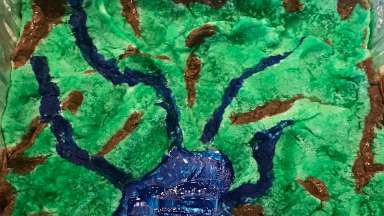Jump To:
The clay watershed model teaches kids about where water flows through the city. Read more about the materials and instructions for the project.
Make the Clay
| Clay Materials | |
|---|---|
| 2/3 cups of salt | 1/2 cup of cold water |
| 1 cup of cornstarch | Food coloring (optional) |
| 2/3 cups of room temperature water | |
- Stir salt, room temperature water, and a few drops of food coloring into a saucepan.
- Heat for 4-5 minutes.
- Remove from heat; add cornstarch and cold water.
- Stir until smooth; return to heat and cook until thick.
- Allow the clay to cool. Set aside. Store leftover clay in a ziploc bag.
Build the Model
| Model Materials | |
|---|---|
| Acrylic paint (brown and green) | Paint brushes |
| Food coloring (blue) | Spray bottle |
| 8x8 foil or tin pan that can hold water | |
- After the clay is dry – use it to form your watershed or land inside the pan. The land should have peaks and valleys. Leave space at the bottom of the pan for the river or lake.
- Paint your watershed. Use brown for exposed earth. Use green for grassy areas. You can also add in small streams leading to a river or lake with pant. Or, add plastic buildings, cars, and a barn with animals to represent impervious surfaces. Be creative!
- Let the paint dry. Fill your spray bottle with water and a few drops of food coloring.
- Spray your watershed from above and watch the water flow. You may need to tip your pan slightly if your model doesn’t have enough peaks and valleys.
What You'll Find
Water flows over hills and through neighborhoods into a stream, creek or river every time it rains. What flows through the watershed can directly affect water quality. There is less water pollution when water flows over open, green space. There is more pollution when water picks up litter and debris as it flows over impervious surfaces (like buildings and roads).
